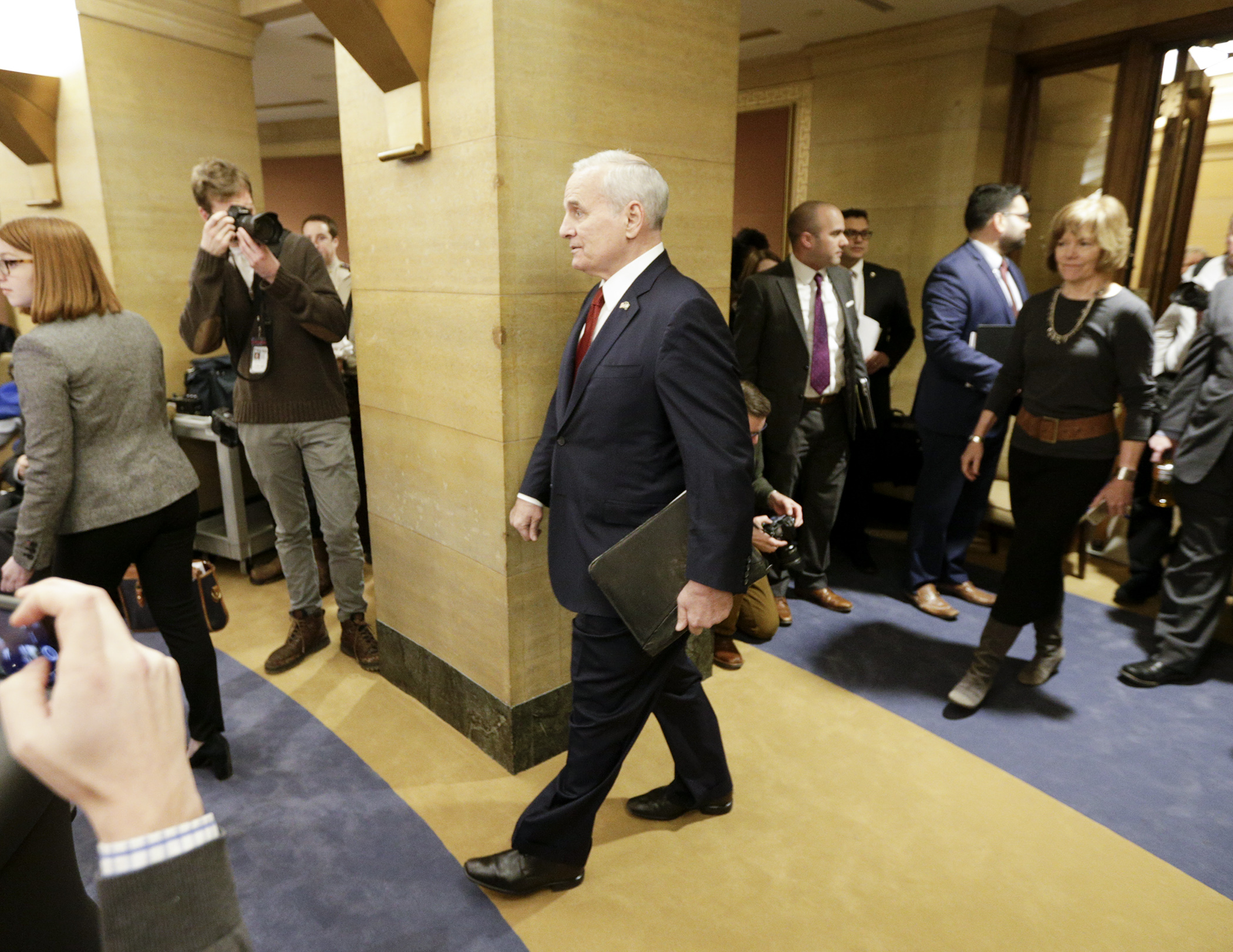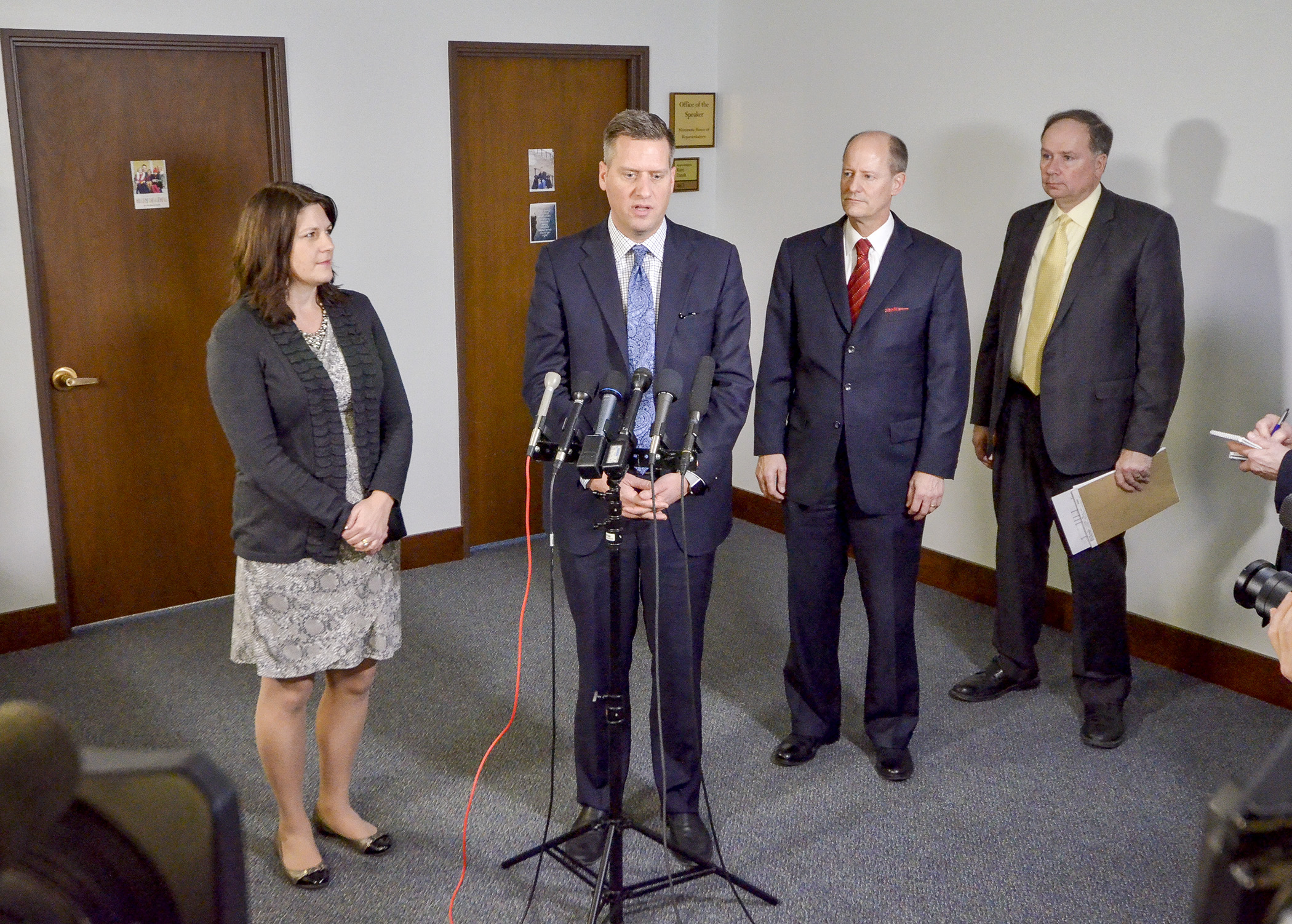Dayton’s budget proposal prioritizes health, education and transportation

Gov. Mark Dayton on Tuesday released a two-year, $45.8 billion biennial budget proposal that includes an expansion of MinnesotaCare, increased education spending and an increase in the state’s gas tax.
The spending plan, called “An Opportunity Agenda for a Better Minnesota,” is about $1.2 billion more than the current two-year budget. It includes expansion to the working family and child care tax credits, would close corporate tax loopholes and include sales tax “clarifications.”
To offset the increased spending, which includes a $312 million insurance premium relief bill, the budget banks on the state’s November forecast that projects a $1.4 billion surplus.
Among the budget increases are $609 million for E-12 education; $62 million for the state grant program to increase student aid for more than 82,000 students; $60 million to further expand broadband in Greater Minnesota; and $20 million to restore funding in a pair of job creation funds that were cut last year.
WATCH Full video of Gov. Dayton's 2017 budget proposal announcement
But Republican lawmakers, who control both chambers of the Legislature, said the DFL governor’s proposal is too bold. Expanding the public health insurance option is a “non-starter,” according to Senate Majority Leader Paul Gazelka (R-Nisswa).
While most decision-makers at the capitol see the same issues, the solutions differ.
“We look for tax relief as well,” Gazelka said in an afternoon media briefing. “That’s an area that I think Minnesotans deserve. We had a $2 billion tax increase four years ago. We now have a surplus, and yet the governor’s proposal is to increase spending 10 percent. Ten percent. That’s just more than we think is appropriate.”
“I was encouraged last night when the governor talked about stability in state government and wanting to sure that we’re maintaining it and finding efficiencies in government. But that growth in spending is a concern,” House Majority Leader Joyce Peppin (R-Rogers) said.
The governor is calling for $300 million in tax relief that, he says, would affect 450,000 Minnesotans and their families. Included in that is $94 million to expand the Working Family Tax Credit to 107,000 new households and $34 million to cut by 40 percent farm property taxes for school district debt. Additionally, he proposes a $61 million Child Care Tax Credit to help 95,000 families afford child care.
Dayton’s budget will be broken down into separate bills and head into a number of committees over the coming weeks.
Public option and health care
 House Speaker Kurt Daudt comments on the governor's biennial budget proposal that was released Tuesday. Also present are House Majority Leader Joyce Peppin, from left, Senate Majority Leader Paul Gazelka and Rep. Jim Knoblach, chair of the House Ways and Means Committee. Photo by Andrew VonBank
House Speaker Kurt Daudt comments on the governor's biennial budget proposal that was released Tuesday. Also present are House Majority Leader Joyce Peppin, from left, Senate Majority Leader Paul Gazelka and Rep. Jim Knoblach, chair of the House Ways and Means Committee. Photo by Andrew VonBankSaying the state needs to “reform for the future,” Dayton unveiled his so-called “public option plan,” an expansion of MinnesotaCare. The public option would require a one-time initial cost of $12 million and shift $716 million from the General Fund into the Health Care Access Fund to help cover costs.
According to Minnesota Management and Budget Commissioner Myron Frans, the reform would expand medical coverage provided through the Health Care Access Fund from 4 percent to 10 percent.
The public option would be sold through MNsure as an additional option on the individual market.
Aware the topic is a lightning rod for Republican lawmakers, Dayton said, “They are concerned about more competition. This is one way of providing more competition.”
Dayton also suggested continuing the provider tax, which is scheduled to end December 2019.
“I believe it would be a serious mistake to eliminate such an essential source of state funding for health care,” Dayton said.
Funding for a health insurance premium relief bill (HF1/SF1*) now in a conference committee is also included in the governor’s plan. Senate and House lawmakers tasked with finding common ground on divergent insurance fixes on Tuesday were nearing a $300 million-plus rebate plan. Dayton signaled Tuesday his administration and top Republican lawmakers were making inroads, but the details are stilling being ironed out.
Dayton’s proposal from the onset has been to spend $312 million for 25 percent across-the-board relief for Minnesotans facing skyrocketing premiums on the individual market.
Transportation and the returning gas tax
Back again this year is a call to increase the state’s gas tax.
It would cost “the average Minnesotan driver $75 a year,” Dayton said. “…It’s not even the Cadillac version. It’s one that will maintain the existing highway conditions and make some easy improvements and expansions.
“If we don’t do that, or don’t do something like it, the guarantee is that the conditions are going to get worse. Highways are going to get more congested. They’re going to become more antiquated; more expensive to repair now and in the future,” Dayton added.
WATCH House/Senate Republican response to the governor's budget proposal
According to the administration, Minnesota is facing an $18 billion transportation funding gap over the next 20 years. Forty percent of new revenues would go to counties, cities and townships to repair or replace 1,700 miles of roads and 235 bridges.
The plan also includes beefing up bus rapid transit and light rail lines in the Twin Cities metropolitan area and 500,000 additional hours of service to Greater Minnesota.
“A little disappointed that he’s still willing to push the gas tax,” Peppin said. “…Certainly roads and bridges will continue to be a priority for our caucus.”
Overall, House Speaker Kurt Daudt (R-Crown) said the governor intends on spending too much and not focusing enough on tax breaks.
“The good news for everyone is that, I think, we see some of the same problems in Minnesota,” Daudt said. “I think we see that middle income Minnesotans aren’t thriving in the way that they should in this economy. We see that young learners in the state of Minnesota need some better options and some better choices to be more successful in their education careers. Frankly, I think we can do better in growing our state’s economy and doing better for all Minnesotans.”
Related Articles
Search Session Daily
Advanced Search OptionsPriority Dailies
Ways and Means Committee OKs proposed $512 million supplemental budget on party-line vote
By Mike Cook Meeting more needs or fiscal irresponsibility is one way to sum up the differences among the two parties on a supplemental spending package a year after a $72 billion state budg...
Meeting more needs or fiscal irresponsibility is one way to sum up the differences among the two parties on a supplemental spending package a year after a $72 billion state budg...
Minnesota’s projected budget surplus balloons to $3.7 billion, but fiscal pressure still looms
By Rob Hubbard Just as Minnesota has experienced a warmer winter than usual, so has the state’s budget outlook warmed over the past few months.
On Thursday, Minnesota Management and Budget...
Just as Minnesota has experienced a warmer winter than usual, so has the state’s budget outlook warmed over the past few months.
On Thursday, Minnesota Management and Budget...